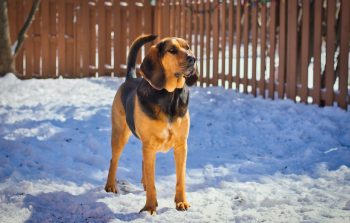The Bloodhound is a large breed dog known for its incredible sense of smell and unparalleled tracking abilities. These gentle giants require regular exercise to stay healthy both in body and mind. This article will discuss the ideal amount and types of exercise for a Bloodhound.
1. Assessing the Exercise Needs of Bloodhounds
Bloodhounds require regular exercise but do not need high-intensity activities; around one to two hours of physical activity per day is recommended. Their exercise should be tailored to their scent-tracking instincts and need for mental stimulation.
2. The Importance of Regular Exercise for Bloodhounds
Exercise is crucial for maintaining the Bloodhound’s physical health, preventing obesity, and minimizing the risk of joint-related issues. It also serves to keep their minds sharp and satisfied.
3. Appropriate Types of Exercise for Bloodhounds
Moderate-paced walking, hiking, and scent work are ideal exercises for Bloodhounds. These activities cater to their natural abilities and provide both physical exertion and mental engagement.
4. Incorporating Scent Work into Exercise Routines
Scent work exercises, such as tracking games or participating in search and rescue activities, are particularly beneficial for Bloodhounds and can provide significant mental stimulation.
5. The Role of Play in a Bloodhound’s Exercise Regimen
Playtime is essential for a Bloodhound’s exercise routine. Engaging in play with robust toys, interactive games, and other friendly dogs can provide both enjoyment and physical activity.
6. Adjusting Exercise for Bloodhound Puppies and Seniors
Bloodhound puppies should have shorter, controlled play sessions to protect their growing joints. Senior Bloodhounds may require gentler, less strenuous exercises to maintain their mobility without causing discomfort.
7. Weather Considerations for Exercising Your Bloodhound
Bloodhounds can be sensitive to extreme temperatures due to their thick coats. Exercise should be adjusted accordingly, with activities during the cooler parts of the day in hot weather and protective measures when it’s cold.
8. Recognizing Signs of Adequate Exercise
A well-exercised Bloodhound will be relaxed at home, maintain a healthy weight, and display a good balance of restfulness and alertness. Inadequate exercise may manifest in restlessness or disruptive behavior.
9. The Connection Between Exercise and Behavioral Training
Exercise sessions are an excellent opportunity to reinforce behavioral training and commands. Consistency and positive reinforcement during activities can help in developing a well-behaved Bloodhound.
10. Regular Health Evaluations and Exercise Adjustments
Routine veterinary check-ups are crucial to ensure that a Bloodhound’s exercise routine remains appropriate as they age and as their health needs evolve. Adjustments may be necessary based on the vet’s advice.
Conclusion
Bloodhounds are not only great companions but also active dogs that thrive with the right amount and type of exercise. A combination of physical activities, mental challenges, and consistent training will ensure a happy and healthy Bloodhound. Owners should always consult with a veterinarian to tailor an exercise plan that suits their Bloodhound’s specific health requirements.
Frequently Asked Questions About Exercising A Bloodhound
1. How much exercise does a Bloodhound need daily?
Bloodhounds typically need at least an hour to two hours of exercise each day. Due to their stamina and tracking instincts, they benefit from both physical activity and mental stimulation through exercises like long walks and scent games.
2. What is the best type of exercise for a Bloodhound?
The best exercise for a Bloodhound taps into their natural tracking instincts, such as scent work or trailing. They also enjoy long walks, hiking in nature, and interactive playtime that allows them to explore and sniff.
3. Are Bloodhounds good running partners?
While Bloodhounds have the stamina for running, they are better suited to activities that engage their sense of smell. If you do choose to run with your Bloodhound, it should be at a moderate pace with plenty of breaks for sniffing around.
4. How do you provide mental stimulation for a Bloodhound during exercise?
Incorporating scent work into a Bloodhound’s exercise routine provides excellent mental stimulation. This can include activities like hiding treats for them to find or participating in tracking sports.
5. Can Bloodhounds participate in dog sports?
Yes, Bloodhounds can participate in dog sports, especially those that involve scent work such as tracking or search and rescue training. These activities provide both the mental and physical exercise that Bloodhounds need.
6. How do I exercise my Bloodhound in bad weather?
Indoor games like hide and seek with treats or toys can keep a Bloodhound mentally stimulated. Short indoor obstacle courses can also provide physical exercise when outdoor conditions are poor.
7. How do I know if my Bloodhound is getting enough exercise?
A Bloodhound getting enough exercise will be relaxed in the home, maintain a healthy weight, and display a calm demeanor. Without adequate exercise, they may become bored, which can lead to destructive behavior or excessive howling.
8. What precautions should I take when exercising my Bloodhound in hot weather?
In hot weather, exercise your Bloodhound during cooler parts of the day, provide plenty of water, and watch for signs of overheating, such as heavy panting or lethargy. Their large size and dark coat can make them prone to heat exhaustion.
9. Do Bloodhounds enjoy water and swimming?
Some Bloodhounds enjoy water and are good swimmers, but others may not be as fond of it. Always supervise swimming sessions for safety and introduce them to water gradually if they are inexperienced.
10. How should I adjust exercise routines for a senior Bloodhound?
Senior Bloodhounds may require less intense exercise compared to their younger counterparts. Gentle walks, shorter hikes, and less demanding scent work are suitable to keep them active without overexertion. Regular veterinary check-ups can help tailor their exercise to their health needs.
The post How Much Exercise Does a Bloodhound Need? appeared first on iHeartDogs.com.

